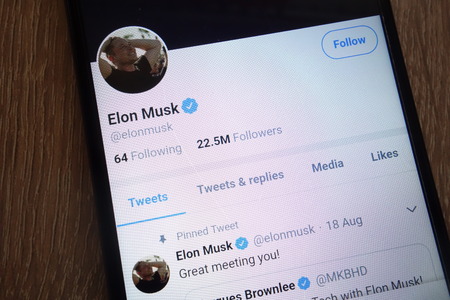
The Elon Musk Financial communication on social networks: guaranteed visibility, questionable effectiveness
“Am considering taking Tesla private at $420. Funding secured.” With a simple tweet posted on August 7th, 2018, announcing his intention to take the company out of the Stock Exchange, Elon Musk, the charismatic and controversial founder of the Tesla company, caused panic at Wall Street . In a few hours, the stock jumped 11% after being suspended. A rise progressively lost in the following days as the doubts about the realisation of the operation were amplified. Because it is not that much the channel used which creates a problem but the very content of the message.
Social networks: new financial communication space
For a long time confined to press releases and financial reports, the financial communication is now allowed on social networks in the United States since a decision of the SEC (Security Exchange Commission), following a publication on Facebook in 2012 by Reed Hastings, Netflix director, announcing that more than a billion hours had been viewed on its streaming site, resulting in a spectacular rise on the stock market.
At first, the SEC announced that the rules of financial communication had not been respected, considering that a post on Facebook was not an official communication and accessible to all investors.
The Netflix director defended himself by presenting his post as a public announcement.
After months of bargaining, the financial regulator dropped its lawsuits and ruled that the social networks could be used for financial communication as long as the access to the platform was not limited and investors were warned in advance of the social network used to communicate.
In the case of Elon Musk’s announcement, the access to his Twitter feed is totally public. More than 22 million subscribers regularly follow its publications. In addition, several important announcements have been made in the past on this channel. In 2015 for example, the leader of Tesla has already surprised the stock market on Twitter by saying that his next product would not be a car. As a result, the mystery surrounding the announcement caused an increase of 900 million euros in the market capitalization of the company.
The channel chosen by Elon Musk to communicate on Tesla is therefore compliant with the rules of financial communication. However, the content of his message might not.
The Elon Musk’s announcement: an unprecedented high-risk of financial communication
Never so far, a leader of a listed company disclosed such sensitive financial company on a social network like Twitter. Announcing that the operation was funded and specifying that the buyback would be proposed at $ 420 per share for shareholders wishing to withdraw from the company, Elon Musk has taken large risks. If it turns out that what he has announced is partly inaccurate, the message of Elon Musk could be considered as a false information to make a stock market fraud. His legal and penal responsibility would then be engaged.
Indeed, the US Stock Market Rule 14e-8 prohibits listed companies to announce their plans to buy or sell securities if the executives do not intend to act on it or do not have the means to finalise it.
And that’s the main problem of Elon Musk’s announcement, which did not provide any information to support his remarks. They have prompted increasingly dubious comments from analysts and the financial press. They underline the fact that the company is not able to go into debt to finance the operation and that investors do not seem to scramble to accompany the whimsical creator of Telsa in his new bet.
From this point of view, there is obviously no difference whatever channel is used, except certainly concerning the speed and the magnitude of the reactions. And once the surprise effect is faded and the buzz erased, Elon Musk finds himself brought back to his company previous situation marked by growing doubts of the financial community on its ability to meet its commitments both in terms of vehicle production and in terms of results. If he fails to complete his project quickly, he will compromise his credibility and might face the same fate as the founder of Uber last year: to be thanked by his board of directors!
